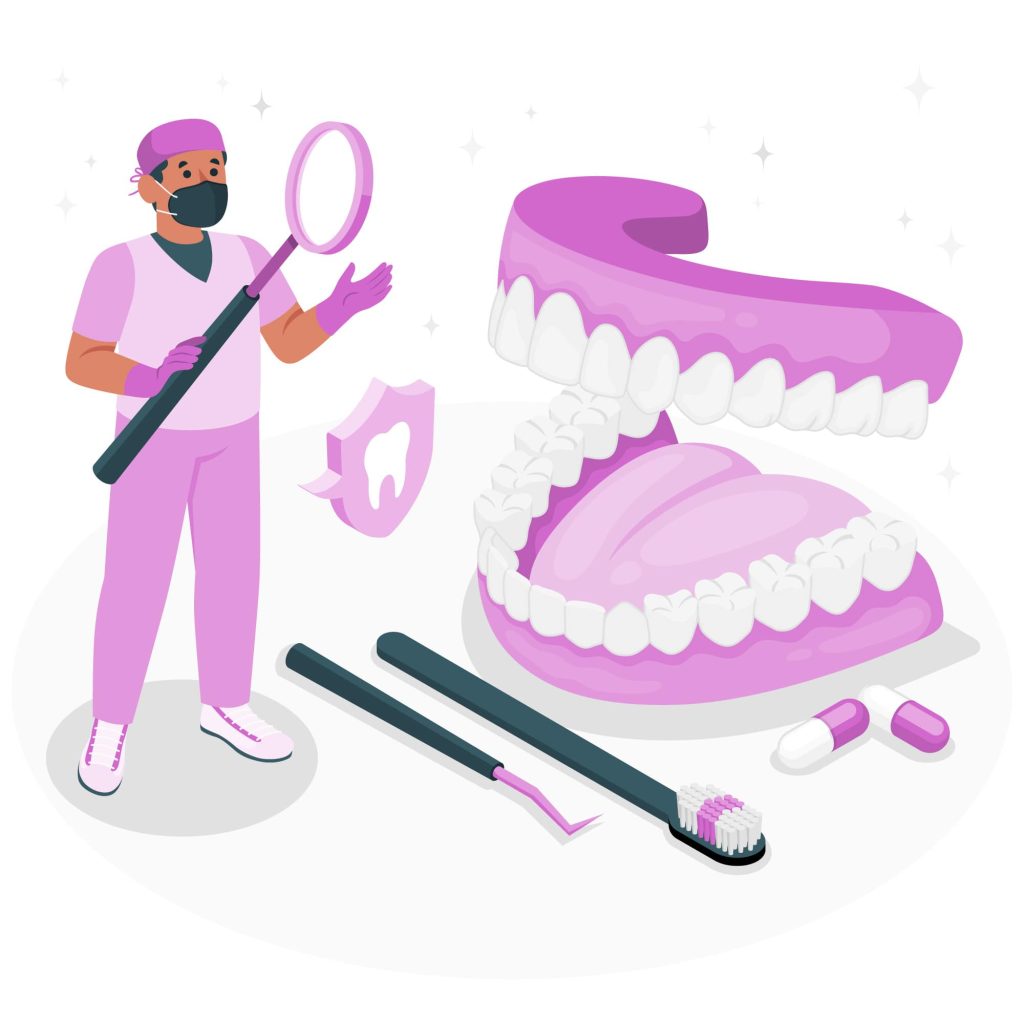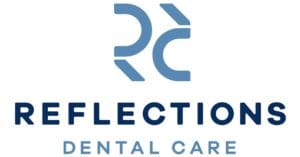At Reflections Dental Care, a common issue we encounter among our patients is gum recession. Gum recession occurs when the gum tissue surrounding the teeth begins to pull back or wear away, exposing the tooth roots. This condition can lead to a variety of problems, including increased tooth sensitivity, a higher risk of cavities, and, if left untreated, even tooth loss. We encourage our patients to pay close attention to their gum health and take action early to prevent these complications.
Many people don’t notice that their gums are receding until the problem becomes more severe. Fortunately, with a simple self-check at home, you can spot the early signs of gum recession and take action before it worsens. Let’s dive into what you need to look for, how to do a quick self-check, and when it’s time to see a dentist in Oklahoma City.
What is Gum Recession?
Before we dive into how to check for gum recession, let’s quickly go over what it actually is. Healthy gums fit snugly around your teeth, providing a barrier against harmful bacteria and protecting the roots of your teeth. However, when gums begin to recede, they pull back from the teeth, exposing parts of the tooth’s root that were previously covered by gum tissue.
This can happen gradually over time, and you may not notice it right away. While it’s normal for some slight gum recession to occur with age, excessive recession can lead to complications, including:
- Increased sensitivity to hot, cold, or sweet foods and drinks
- More visible tooth roots
- Higher risk of gum disease
- Aesthetic concerns (teeth may appear longer than they actually are)
- A higher likelihood of tooth decay or infection
Why Does Gum Recession Happen?
There are several reasons why gums might begin to recede. Some of the most common causes include:
Gum Disease: Bacteria from plaque and tartar build-up can infect the gums, causing inflammation and eventually leading to gum recession.
Brushing Too Hard: Using a hard-bristled toothbrush or brushing your teeth with excessive force can wear away gum tissue over time.
Genetics: Some people are more predisposed to gum recession due to their genetics.
Teeth Grinding (Bruxism): Clenching or grinding your teeth can put excessive pressure on your gums, causing them to recede.
Hormonal Changes: Pregnancy, menopause, and puberty can affect gum health, making gums more susceptible to recession.
Tobacco Use: Smoking or chewing tobacco can weaken the gums and make them more likely to recede.
Now that we have a basic understanding of gum recession, let’s look at how you can perform a simple self-check at home to determine whether you might be experiencing this issue.
Teeth Gum Recession Self-Check: What to Look For

1. Exposed Tooth Roots
One of the most obvious signs of gum recession is the appearance of exposed tooth roots. Healthy gums cover the entire surface of the tooth, but when gums recede, the roots of the teeth become visible. Tooth roots appear darker than the rest of the tooth and may look yellowish or slightly brown.
To check for exposed roots, use a mirror and gently pull back your lips and cheeks. Look closely at each tooth to see if the roots are visible. If you notice that your teeth appear longer than usual or there are visible gaps between the teeth and the gums, this could be a sign of recession.
2. Tooth Sensitivity
If you’ve ever felt sharp pain when drinking a cold beverage or eating something hot, you may have experienced tooth sensitivity. Tooth sensitivity is a common symptom of gum recession. When the gums recede, the sensitive roots of the teeth are exposed, making them more vulnerable to temperature changes.
To check for sensitivity, pay attention to any discomfort you feel while eating or drinking. If you experience sensitivity, particularly when consuming hot, cold, sweet, or acidic foods and drinks, it’s a good idea to investigate further. If the sensitivity is localized to certain teeth, gum recession could be the culprit.
3. Look for a “V” Shaped Notch at the Gum Line
When the gum tissue pulls away from the teeth, it often forms a “V” shaped notch along the gum line. This can sometimes be a subtle sign of gum recession. To check for this, gently run your finger along the base of your teeth, where the gum and teeth meet. If you feel or see any indentations, it could indicate that the gum tissue is receding.
This notch might also feel slightly rough or different from the smooth surface of the rest of the tooth.
4. Swollen or Bleeding Gums
If your gums bleed when you brush or floss, this could indicate gum disease, which is a major cause of gum recession. Healthy gums shouldn’t bleed easily. If you notice bleeding, especially after brushing or flossing, this could be a sign that your gums are inflamed, and gum recession may follow if left untreated.
Additionally, swollen or puffy gums are another indicator of gum disease, which can eventually lead to recession. If you notice any swelling or redness around your gums, take action to improve your oral hygiene, and consult your dentist.
5. Gum Line Pulling Away from the Tooth
One of the most noticeable signs of gum recession is when the gum line visibly pulls away from the teeth. If you notice that your gums seem to be shrinking, especially in certain areas, this could be a clear sign of recession. A receding gum line will create visible gaps between the teeth and gums.
To check for this, look closely in a mirror and inspect the gum line around each tooth. Pay attention to areas where the gum line seems higher or lower than it should be. If you spot any irregularities, it’s time to consult with your dentist.
6. Changes in Your Smile
If your smile appears different, it could be due to gum recession. The teeth may appear longer than before, or the gums may look uneven. This change in appearance is often due to the recession of gums, which exposes more of the tooth’s surface. If you notice these cosmetic changes, it’s important to check for other signs of recession as well.
Don’t ignore the signs of gum recession. If you’ve noticed any of these symptoms, call us today at (405) 751-4556 for a consultation and take the first step toward healthier gums and teeth in Oklahoma City, OK!
What to Do if You Spot Signs of Gum Recession
If you notice any of the above signs, it’s important to take action right away. While a self-check is a great first step, you should schedule an appointment with your dentist to get a professional evaluation. Your dentist will be able to measure the depth of the gum recession and determine the underlying cause.
Preventing Gum Recession
While it’s important to catch gum recession early, prevention is always better than treatment. Here are some simple tips to help prevent gum recession:
Brush Gently: Use a soft-bristled toothbrush and brush gently. Avoid brushing too hard or using abrasive toothpaste, as this can wear away the gums.
Floss Regularly: Flossing helps remove plaque and food particles between your teeth and along the gum line, reducing the risk of gum disease and recession.
Avoid Tobacco Products: Smoking or chewing tobacco weakens the gums and increases the likelihood of recession.
Use a Mouth Guard: If you grind your teeth at night, talk to your dentist about getting a mouth guard to protect your gums from pressure.
Regular Dental Visits: Regular check-ups with your dentist will help catch early signs of gum recession and allow for prompt treatment.
Summary
Gum recession is a common issue that can lead to serious oral health problems if left untreated. By performing a simple self-check at home, you can spot the early signs of gum recession and take steps to prevent it from getting worse. If you notice any of the signs mentioned in this guide, it’s important to see a dentist for a thorough evaluation.
At Reflections Dental Care in OKC, we’re committed to helping our patients maintain healthy, beautiful smiles. If you suspect you may have gum recession or if you’re due for a check-up, don’t hesitate to contact us for an appointment. Together, we can protect your oral health and keep your gums in great condition! Call us now at (405) 751-4556.


